Bigger cancer budget equals better treatment, fewer deaths in PH
MANILA, Philippines—Increasing cancer funds could help bring more patients closer to treatment and recovery, medical experts said.
For many years, cancer has been one of the leading causes of death in the Philippines.
According to data from the Philippine Statistics Authority (PSA), neoplasms—commonly known as “cancer”—were the third leading cause of death in the country, which accounted for 42,497 recorded cases (10.2 percent share) from January to September 2022.
The dreaded disease is known to be the cause of death of four Filipinos every day.
Estimates by the Global Cancer Observatory (Globocan) found that 153,751 Filipinos suffer from various types of cancer as of 2020. Among these were 27,163 breast cancer patients, 19,180 lung cancer patients and 17,364 colorectum cancer patients.
Article continues after this advertisementMedical advances have, however, made cancer preventable and treatable—helping many cancer patients recover and successfully win their battle against the “Big C.”
Article continues after this advertisementCancer is beatable
“We can beat cancer now. We can save lives. And we are trying our best to make treatment accessible nationwide, especially to those who cannot afford the treatment,” Dr. Marvin Mendoza, head of the oncology section at the National Kidney and Transplant Institute (NKTI), previously said.
Cancer treatment involves radiation therapy, immunotherapy, targeted therapy, and chemotherapy.
Dr. Marigold Ferrolino, head of the oncology department at the Rizal Medical Center (RMC), said doctors might also prescribe injection or oral chemotherapy, or radiation targeting the tumor or cancerous tissues—which, she explained, does not cause common side effects such as falling hair or balding.
The RMC, according to radiation oncologist Dr. Antonio Alonzo, also offers high-energy X-rays, “the gold standard of modern machines.” This machine, used to kill cancer cells, uses artificial intelligence (AI) to treat cancer patients.
While the cost of radiation treatment usually ranges from P300,000 to P450,000 in private hospitals, at RMC, patients would pay a “minimal” amount.
Alonzo also stressed that the risk of a patient being afflicted with cancer because of radiation is “very minimal.”
According to the Philippine Cancer Society, targeted therapy—which uses targeted drugs or medicines that work differently than standard chemotherapy drugs—is most often used along with chemotherapy.
READ: Long lines, lengthy treatment wear out PH cancer patients
These medicines—which offer hope for treatment even in severe cases where cancer has already spread to other organs—were recently made more accessible to Filipino cancer patients.
In a statement last February 9, the NKTI announced that 23 public hospitals have started offering free targeted therapies for breast cancer patients who cannot afford the required 18 treatment cycles, which cost from ₱300,000 to ₱450,000.
“Options for treatment include a subcutaneous injection that takes about 5 minutes to administer or a three-hour intravenous administration that also requires an additional two hours or so for preparation,” said Dr. Mendoza.
READ: Targeted therapy makes waves as brightest hope for cancer treatment
Boost budget
However, while modern medicines and equipment for free cancer treatment were already made more available locally, boosting the government’s cancer funds could help make affordable treatment accessible to more patients.
Mendoza said only 200 patients would be accommodated nationwide for the free 19-month cancer treatment cycle due to the limited budget for the treatment program—covered by the Department of Health’s (DOH) P1.56 billion worth of cancer funds.
READ: More funding, assistance bring cancer patients closer to recovery
“We can beat cancer. We can save lives. We can do more if the budget is increased by Congress,” Mendoza said.
Statistics showed that at least 7 in 10 cancer patients in the country “drop out of treatment regimen” due to lack of funds.
READ: Cancer assistance fund of P529.2M available until end of 2023 – DBM
A study published in 2018 in Acta Medica Philippina—a peer-reviewed general medical and health science journal published by the University of the Philippines (UP)—highlighted the economic impact of cancer diagnosis in families.
The study, which analyzed 909 cancer patients in the Philippines, found that 40.6 percent of cancer patients’ families experienced financial toxicity—or financial problems—due to the high cost of medical care.
The researchers also found that the mean combined out-of-pocket expenses of respondents at 3 and 12 months after diagnosis amounted to P181,789.00.




